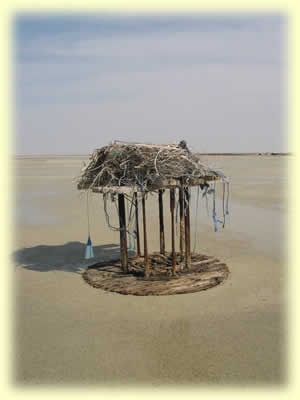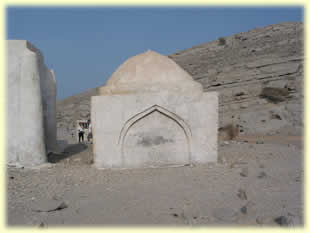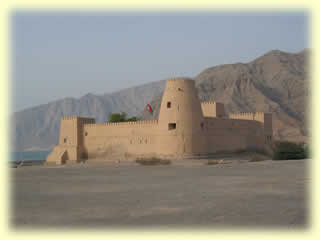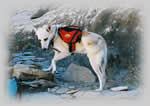|

 To
those of you in the UAE who think that you can't get out and about
during the summer months because of the heat and humidity; I can
tell you that we had three excellent summer weekends away. One excursion
was a day trip, and for the other two we camped! The trick to enjoying
(surviving?) the outdoors in the summer, is either to be near the
sea, or by the pool, with access to shelter from the sun, or do
as we did for the camps and get up high in the mountains. To
those of you in the UAE who think that you can't get out and about
during the summer months because of the heat and humidity; I can
tell you that we had three excellent summer weekends away. One excursion
was a day trip, and for the other two we camped! The trick to enjoying
(surviving?) the outdoors in the summer, is either to be near the
sea, or by the pool, with access to shelter from the sun, or do
as we did for the camps and get up high in the mountains.
Our first trip was to the mountains near Aqabat Oso, the village
at the top of the mountain pass between wadis Bih and Khabb Shamsi.
We were doubly fortunate in that, not only did we have a good breeze,
free of humidity, but we also awoke to an overcast sky which kept
off the fierce sun well into the day. The morning clouds provided
us with fine drizzle; not enough to soak us through or make the
tents too wet to pack away, but enough to keep us cool. In fact
the temperatures were so pleasant that we were able to walk comfortably
part of the Jebel Qihwi route. We walked for over an hour and a
half in total and climbed about 250m; this would usually be very
difficult at this time of year, even at this altitude (1000m).
 We
left Aqabat Oso, late morning and descended in the rain to Dibba
via Wadi Khabb Shamsi. I must admit to being a little nervous going
through the narrow gorges with the windscreen wipers going. I wouldn't
ordinarily recommend this route in the rain. In truth it never really
looked like changing from anything but a fine drizzle, and we emerged
with nothing worse than muddy tires. Even though the weather down
near Dibba was much more humid it was still cooler than normal,
and quite bearable. For lunch we headed over to the ruins of the
palace in wadi Hayl and after paying a quick visit to see the petroglyphs,
headed back to Abu Dhabi, via Kalba and the recently opened, 1km
tunnel to Huwailat. We
left Aqabat Oso, late morning and descended in the rain to Dibba
via Wadi Khabb Shamsi. I must admit to being a little nervous going
through the narrow gorges with the windscreen wipers going. I wouldn't
ordinarily recommend this route in the rain. In truth it never really
looked like changing from anything but a fine drizzle, and we emerged
with nothing worse than muddy tires. Even though the weather down
near Dibba was much more humid it was still cooler than normal,
and quite bearable. For lunch we headed over to the ruins of the
palace in wadi Hayl and after paying a quick visit to see the petroglyphs,
headed back to Abu Dhabi, via Kalba and the recently opened, 1km
tunnel to Huwailat.
The following weekend we did a day trip to the seaside, but this
was a seaside with a difference! This trip involved wading through
shallow creeks, and plodding through mud, at times knee deep. We
were amongst the mangrove forests at Ras Dhabiyah, which is a short
way along the coast, east of Abu Dhabi Island.
 If
you've ever seen the Bogart film African Queen, then you'll have
some idea of what this hike in the mangrove forest was like. I've
always wondered what it was like, up close and personal with a mangrove
swamp, and often thought it'd be fun to take a canoe through the
channels in the mangrove swamps just off the New Corniche in Abu
Dhabi. Ok, ok, we all have our fantasies!! If
you've ever seen the Bogart film African Queen, then you'll have
some idea of what this hike in the mangrove forest was like. I've
always wondered what it was like, up close and personal with a mangrove
swamp, and often thought it'd be fun to take a canoe through the
channels in the mangrove swamps just off the New Corniche in Abu
Dhabi. Ok, ok, we all have our fantasies!!
As you may expect, among the wildlife to be seen were crabs, birds
(heron, curlew, plovers, hoopoe lark, flamingos, Osprey), a myriad
of small shellfish, and a few small fish in the creek. The mangroves
themselves are quite interesting with their snorkel-like roots pointing
upwards and spreading out a surprising distance from the main plant.
Amongst the mangroves were a few rocky outcrops; eroded remains
of ancient seabed. Some of these mushroom shaped rocks were 3-5m
above the ground, so it was interesting to climb up on top and get
a good look around from above. One thing I learned was that if you
had to travel any distance through the mangroves it would be very
easy to become disoriented and lost. Making our way directly to
one of the outcrops which we'd spotted just 100m away was much more
difficult than I would have imagined.
 If
you are tempted to have a go at "Mangrove Plodding", and
I will quite understand if you are not, then choose your footwear
carefully. Bare-feet are out; the shells in the mud would make a
mess of all but the hardest of hard-skinned feet. Reef-type sandals
tend to let the small sharp shells get between your toes and under
the soles of your feet (very uncomfortable), trainers are in danger
of getting stuck in the mud and being lost for ever, and the same
goes for flip-flops (Jandals, thongs, whatever they call them in
your neck of the woods). The best footwear, we found, was neoprene
diving bootees, the type that you struggle to get on or off because
they seem to adhere to your feet. Anyway, it was a pleasant and
interesting way to pass a Friday, and with the water close to hand,
aided by a bit of a breeze, we managed to avoid overheating. I'm
just glad we didn't take our dog Chirri; he would have got in a
terrible muddy smelly mess. A bit like us really! If
you are tempted to have a go at "Mangrove Plodding", and
I will quite understand if you are not, then choose your footwear
carefully. Bare-feet are out; the shells in the mud would make a
mess of all but the hardest of hard-skinned feet. Reef-type sandals
tend to let the small sharp shells get between your toes and under
the soles of your feet (very uncomfortable), trainers are in danger
of getting stuck in the mud and being lost for ever, and the same
goes for flip-flops (Jandals, thongs, whatever they call them in
your neck of the woods). The best footwear, we found, was neoprene
diving bootees, the type that you struggle to get on or off because
they seem to adhere to your feet. Anyway, it was a pleasant and
interesting way to pass a Friday, and with the water close to hand,
aided by a bit of a breeze, we managed to avoid overheating. I'm
just glad we didn't take our dog Chirri; he would have got in a
terrible muddy smelly mess. A bit like us really!
And then, as if it couldn't get any better, a visit to Musandam
turned into a surprise opportunity to achieve something on my must-do
list. We planned to spend two nights in the Musandam, the most northerly
part of Omani territory, and one of its most fascinating areas.
Because we couldn't leave Abu Dhabi until after 4 pm on Wednesday
which meant arriving in Khasab after 9 pm, we planned to spend the
first night at the Khasab hotel. Ten more members of the group were
due to leave early Thursday morning and meet us in Khasab around
midday.
On Thursday morning we got up early and made the 30min journey
to Khawr Naj'd, in order to try and arrange the hire of a Dhow.
We wanted a boat to take us over to the deserted village of Maqaqah
on the northern shores of this fantastic Fjord-like inlet (Khawr
Habalayn), which opens out into the Indian Ocean on the peninsula's
east coast. The village has a small island nearby (Jazirat Maqaqah),
and there are reportedly some interesting archaeological remains
in the area. Two years previously, at about the same time of year,
on a boat trip up Khawr Ash Shamm, we climbed the narrow ribbon
of rock which separates that inlet from Khawr Habalayn and looked
down through the sweat in our eyes at the inviting waters below.
So it seemed only right that this time we should visit the clear
waters of Khawr Habalayn.
Unfortunately, we found that the only vessels at Khawr Naj'd were
small fishing launches, and worse still, the beach was deserted.
After a short wait, a small boat arrived and took aboard some workmen
before heading off south to Lima. We learned from the foreman that
they were workers from the power station and the workers had been
called to Lima to fix a problem with the electricity supply there.
It didn't seem worthwhile waiting for a dhow to somehow magically
appear, so we headed back into Khasab where we visited one of the
tour companies which specialise in providing sea transport to tourists.
We discussed our problem and discovered that indeed, there were
no dhows normally resident at Khawr Naj'd and to be able to visit
Maqaqah a boat would have to be sent all the way round from Khasab;
a journey of over 100 km. We were assured that they were more than
willing to do this for us, but in this case it would have taken
too long for the Dhow to get round in the time we had available,
plus the cost spread amongst our small party would have been quite
high.
We started looking at alternative possibilities, knowing that everyone
would be disappointed if we didn't go on some sort of boat trip
along this amazing coastline, when Ali, the tour operator mentioned
Kumzar. This rang a bell. I had read all about Kumzar and its intriguing
history involving Iran, Arabia, India, Portugal and England. The
language of the Kumzari people is apparently an unusual dialect
which appears to be influenced by the language from all five of
these regions. Today Kumzar is very much a part of Oman and has
a reported population of 3000, although there was only a handful
there when we visited. These days the people tend to move to Khasab
during the hottest months.
 When
the rest of the group arrived at around 2pm we had the boat organised
and were very soon on our way to visiting Kumzar, something I'd
wanted to do for a very long time. A full account of what we found
there deserves a page of its own. Suffice to say it was an absolutely
fantastic trip, which more than made up for our disappointment at
not being able to visit Maqaqah. We'll have to save that for the
next trip! When
the rest of the group arrived at around 2pm we had the boat organised
and were very soon on our way to visiting Kumzar, something I'd
wanted to do for a very long time. A full account of what we found
there deserves a page of its own. Suffice to say it was an absolutely
fantastic trip, which more than made up for our disappointment at
not being able to visit Maqaqah. We'll have to save that for the
next trip!
We didn't arrive back in Khasab until gone 10 pm, so we quickly
packed the vehicles and made our way up to the camp near the top
of Jebel Harem. We had a late night supper and retired to our tents
after 1 am. The night was very pleasant, and cool enough to sleep
comfortably in our tents. In the morning we walked a short distance
from the camp to a viewpoint where we could just make out Aqabat
Oso, the area in which we'd camped two weeks earlier.
 After
packing up we drove to a small wadi near the Sayh plateau which
leads to the 'hidden valley'. This is where the village at the top
of the 'Stairway to Heaven climb' is situated, and so we were able
to peer gingerly over the edge, and wonder how on earth anyone could
climb up there from wadi Ghalilah / Litibah far below. After
packing up we drove to a small wadi near the Sayh plateau which
leads to the 'hidden valley'. This is where the village at the top
of the 'Stairway to Heaven climb' is situated, and so we were able
to peer gingerly over the edge, and wonder how on earth anyone could
climb up there from wadi Ghalilah / Litibah far below.
Time was marching on so we headed back to the cars and drove back
down to Khasab. From there we just didn't seem to be able to drag
ourselves away and back over the border to the UAE. What with side
trips to see more petroglyphs, the Shrine to Sheikh Masud in his
beautifully secluded cove, then the restored mosque, fort and hill-fort
at Bukka, it was nearly dark as we crossed the border back into
the UAE with the long journey to Abu Dhabi ahead of us.
We arrived home tired but satisfied, and so it just goes to show
that you can still have adventures in summer in the UAE!
Roy Richards July 2003
© Roy L Richards 2012
Contact for problems, queries etc:
|
Updated Jan 2010
|
|

|
|
|
|

|
|
|





